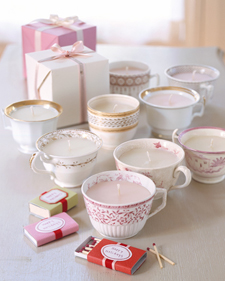Have your eye on Joelle Hoverson's bedroom quilt, featured in Blueprint's May/June issue?
Why not try it yourself? "This quilt top is very easy to make, even if you're new to quilt making," Joelle says. "The design is created simply by sewing strips around a center piece to form concentric rectangles." Below are Joelle's step-by-step instructions.
Finished Measurements:Approximately 80 inches by 96 inches (fits a queen-size bed)
Tools and Materials
A combined total of approximately 7 to 8 yards of 45-inch-wide fabric in a pleasing color palette. For the quilt shown here, Joelle started with 3/4 to 1 yard each of 8 different fabrics in a range of light neutrals and pinks, some prints and some solids.
Patchwork Quilt How-To
1. Wash, dry, and iron all fabrics.
2. Using a rotary cutter, cutting mat, and a straightedge ruler, cut each piece of fabric into 45-inch-long strips (from one finished edge of the fabric to the other) of the following widths:
1.5 inches
2.5 inches
3.5 inches
4.5 inches
6.5 inches
Cut as many as you can from the fabric available, being sure to cut at least one of each width in each fabric.
3. Trim the selvages (the finished edges) from each strip, and organize them in piles by width.
4. Select one 6.5-inch-wide strip and cut it to create a rectangle for the center of your quilt. She cut hers into a 6.5-by-7.5 inch rectangle. Set the remainder aside for use in piecing the rest of the quilt.
5. Select your second strip, place it on top of the center rectangle with one edge aligned, right sides together. Pin it in place, then sew the pieces together along that edge, leaving a 1/4-inch seam allowance. (You'll use 1/4-inch seams throughout.) Trim off the excess length of the strip.
6. Unfold the sewn rectangles and press the seam to one side.
7. Select your third strip and prepare to add it to the others. Each time you add a strip to the quilt, you will follow the same steps: Position the existing work right side up, with the most recently added piece on the left side. Place the new strip right side down along the top edge, pin it into place, and stitch it to the quilt. Trim off the newest strip's excess length, and press the seam to the side.
8. Rotate the existing work so that the newest strip is on the left side, and continue adding pieces in this way until the quilt is approximately 40-by-40-inches wide.
9. Once the quilt has reached this size, you'll need to piece some of your remaining strips together along their short sides before sewing them onto the quilt edges as described above. (As the quilt gets even larger, you may need to piece 3 strips together to measure the length of one side.)
10. Continue adding strips until the quilt is large enough to cover your bed.
11. Once you've finished piecing the top of the quilt, you will need to baste it, quilt it, and bind it.



























